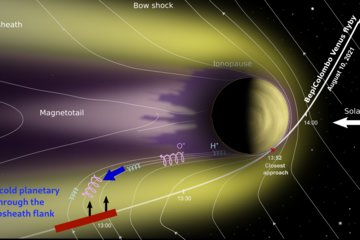All genres
141.
Journal Article
Most desirable terrain, e.g., flat vs valley location. Handbook for MAP 14, pp. 246 - 248 (1984)
142.
Journal Article
Increase of antenna area instead of transitted power. Handbook for MAP 14, pp. 257 - 258 (1984)
143.
Journal Article
Further developments of EISCAT as an MST radar. Handbook for MAP 14, pp. 309 - 318 (1984)
144.
Journal Article
The MST radar technique. Handbook for MAP 13, pp. 187 - 232 (1984)
145.
Journal Article
Chung-Li, Taiwan dual mode (Doppler and spaced antenna) VHF radar: preliminary specifications. Handbook for MAP 9, pp. 383 - 386 (1983)
146.
Journal Article
VHF Radar Measurements during MAP/WINE. Handbook for MAP 9, p. 344 (1983)
147.
Journal Article
Observations of the HF-enhanced plasma line with a 46.8-MHz radar and reinterpretation of previous observations with the 430-MHz radar. Journal Geophysical Research 88, pp. 2083 - 2092 (1983)
148.
Journal Article
Pulse length dependence of radar signal strengths for Fresnel backscatter. Radio Science 18, pp. 1312 - 1324 (1983)
149.
Journal Article
Comparison of tropopause height and frontal boundary locations based on radar and radiosonde data. Geophysical Research Letters 10, pp. 325 - 328 (1983)
150.
Journal Article
EISCAT - Das europäische Incoherent-Scatter-Radar zur Erforschung der polaren Atmosphäre. Mitt. Astron. Gesellschaft 58, pp. 67 - 79 (1983)
151.
Journal Article
Morphology of the scattering target and turbulent mechanisms. Handbook for MAP 9, pp. 68 - 70 (1983)
152.
Journal Article
Spectral characteristics of the return. Handbook for MAP 9, pp. 112 - 113 (1983)
153.
Journal Article
Interpretation of radar returns from clear air - discrimination against clutter. Handbook for MAP 9, pp. 114 - 119 (1983)
154.
Journal Article
Origin of refractive index fluctuations in the mesosphere as opposed to the stratosphere and troposphere. Handbook for MAP 9, pp. 143 - 144 (1983)
155.
Journal Article
Techniques for measurements of horizontal and vertical velocities. Handbook for MAP 9, pp. 150 - 161 (1983)
156.
Journal Article
Determination of vertical and horizontal wavelengths of gravity waves. Handbook for MAP 9, pp. 262 - 267 (1983)
157.
Journal Article
Parameterization of Fresnel returns. Handbook for MAP 9, pp. 286 - 288 (1983)
158.
Journal Article
Relationship of strength of turbulence to received power. Handbook for MAP 9, pp. 302 - 303 (1983)
159.
Journal Article
Distributed vs. single transmitter. Handbook for MAP 9, pp. 408 - 409 (1983)
160.
Journal Article
Correlation methods. Handbook for MAP 9, p. 527 (1983)











